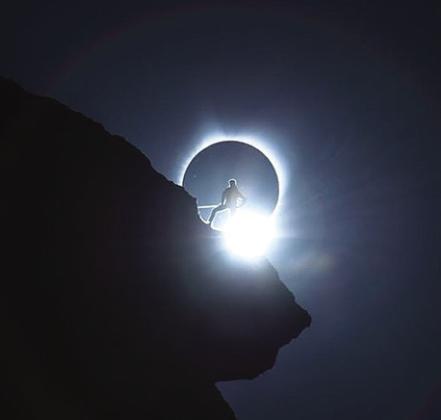Burnet City Council recently allocated thousands of dollars for communications gear needed to accommodate an extraordinary amount of tourists expected to trek through Burnet during the upcoming total solar eclipse day.
During its Feb. 13 meeting, the council approved $120,000 to help locals cope with a high number of visitors - 30,000 or more - expected to arrive by 1:30 p.m. Monday, April 8, when experts anticipate the total eclipse will happen in Burnet.
“Traffic that Monday could be an absolute disaster,” City Manager David Vaughn told council members during the meeting. “There will be lots of things we will have to do. We have to treat (eclipse day) like a public emergency.”
Many astronomers believe Burnet, Lake Buchanan and other areas nearby will be among the best places anywhere on Earth to experience the eclipse – a rare astral phenomenon.
“The lake is the centerline of the (eclipse) path,” Vaughn said. “But Burnet will still experience significant darkness.”
As such, the number of residents and visitors in Burnet may temporarily equal or exceed the population of Ft. Hood.
Indeed, the total number of visitors within all of the Hill Country during eclipse day could equal or exceed 150,000, about four times its normal population.
“We need to be prepared to provide a safe environment for our visitors and employees who will be working the event,” Vaughn told the council.
All Burnet city officials and employees will be available to help first responders assist and monitor the general public as required during eclipse day, Vaughn said.
“It will be all hands on deck,” the city manager added. “We have to focus on getting police, fire department and emergency medical services to people who need them and to get people to go where they need to go, when they need to get there.”
As such, the city is prepared now to procure and install drones, message signs, portable radios and other electronic transmission equipment needed to support visitors during eclipse day.
Also, Vaughn said, state officials may provide Burnet with temporary portable cellular towers to help facilitate efficient phone connections during April 8.
Also for consideration, because of the unusual high level of local road traffic and presumably long lines and waits for food service at local restaurants, the city may have to hire special catering for city employee meals during eclipse day, the city manager added.
“That isn’t cheap,” Vaughn said.
The term “total solar eclipse” is used to describe the flight path of the moon as it orbits between Earth and the sun, to the point where the lunar mass will cast one colossal shadow over Earth.
Around 12:17 p.m. April 8 Burnet time, as the moon moves between Earth and the sun - in a slow but steady fashion through a southwest to northeast corridor, the customary fire ball form of the sun will begin to change into a large but slim crescent shape – until it resembles one young lady’s tender ear – growing progressively thin as the moon continues to shift over Earth.
By 1:35 p.m. in Burnet, the moon will block the sun completely. During that “totality” phase of the eclipse, observers on the ground may see and feel the experience of nighttime darkness during a typical daytime hour.
During the next four minutes, many people may view above their heads a trim ring of spacious illumination behind the moon, which will look like a large black dot.
To be sure, if onlookers decide to stare upwards into the sky to see the eclipse as it happens, they must wear special sunglasses to prevent intense residual glare emitted by the sun affect permanent damage to their eyesight.
Turning to other matters during the Feb. 13 meeting, the council agreed to transfer more than $508,000 to the Delaware Springs Golf Course reserve fund. The amount totals the golf course net operating profit during Fiscal Year 2022-2023.
The transfer hikes the golf course reserve fund to more than $1 million and allows course managers to operate with no or little reliance on a subsidy from the general fund, Finance Director Patricia Langford pointed out.
“That is awesome,” Councilmember Tres Clinton said.
Also, the council authorized a contract with Lenslock to implement a new body and car video system for the police department. The contract will charge more than $238,000 over five years, officials said.
Currently, Burnet police utilize Motorola devices to capture and monitor video and interactions, Vaughn said.
However, several supply and technology issues recently forced the city to consider other systems, he added.
“Lenslock will provide greater capabilities at a reduced cost in comparison to our current system,” Vaughn said.
Moreover, the council approved unanimously the first reading of an ordinance to lower the speed limit from 65 mph to 60 through Texas 29 within Burnet city limits between Park Road 4 and Wild Sage Drive.
Before the council voted, nearby residents suggested perhaps additional measures could be implemented to enhance traffic safety in the area.
“We will reach out to TxDOT to discuss options,” Vaughn told the Bulletin, referring to Texas Department of Transportation officials.
For now, the proposed new speed limit is on hold, pending the outcome of a second reading during a future council meeting, the city manager added.
Also, the council approved the Westfall subdivision phase final plat, including 44 lots over more than 14 acres, as well as a letter of credit to assure completion of the subdivision infrastructure and; agreed to waive the amount of $250 for permit fees needed to support construction of affordable rental housing at 310 E. Third St.



